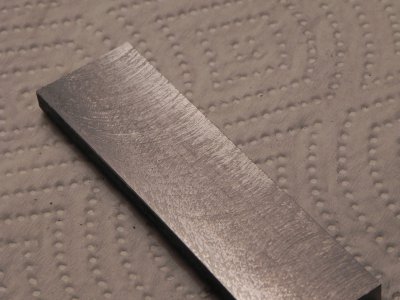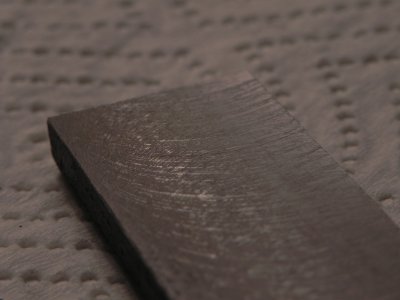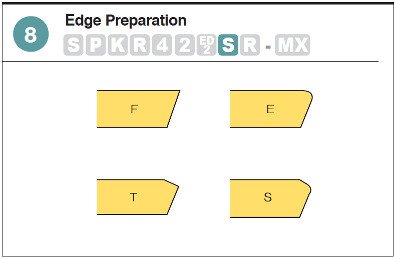- Joined
- Aug 26, 2013
- Messages
- 1,061
I made some more progress on this issue tonight, after contacting Korloy directly yesterday. The first interesting thing I found out, is that the X45 chipbreaker is a special one and not normally for-sale. Thus why they are so readily available on eBay wasn't something the sales representative wanted to talk about.
I did however get the corrected milling parameters for the inserts from him.
P
* Vc 200 - 1150 sfm
* Fz = 0.002 - 0.014 ipt
* Ap = 0.004 - 0.235 in
M
* Vc = 200 - 920 sfm
* Fz = 0.002 - 0.014 ipt
* Ap = 0.004 - 0.235 in
With the corrected info in hand, and a scratch pad i set about systematically testing the working envelope of the inserts. The stock I ran the tests with A36, i figured if i could get a good finish on that horrendous stuff, I could get a good finish on just about anything. After almost 4 dozen test cuts, I got what i think is pretty much the best finish possible with these inserts on my machine. The parameters that worked best, are as follows:
I had to remove all the insets except for one so i could get a high chip-load.
Vc = 774 sfm - this is as fast as my machine can spin (1970 rpm) a 1.5" diameter cutter.
Fc = 0.0147 ipt - This is as fast I could feed (rapid traverse ~29 ipm), given the spindle speed. Chipload seemed to have the greatest effect on surface finish.
Ap = 0.010 in - depth of cut seemed to have the least effect on the surface finish. anything above 0.005" (smeared bellow this), and less than 0.040" (started self feeding above this because of the climb cut) worked equally well.
These two photos show the surface finish I got. Though it looks worse than the 4140, it's actually a smoother finish. I cant feel the ridges with my finger tips, and I can just barely feel them with my fingernail if i scratch it just so.


To get a better finish I would need to do the following.
1) switch to an insert with a better edge perpetration, as this "S" style is probably the worst one possible for generating a good shearing action (see diagram). A "T" or ideally an "F" preparation would be better, but more fragile.

2) Use a larger face mill. A 2" would let me run right at the maximum sfm the inserts can handle, and a 2.5" or 3" would let me drop down a spindle speed and still maintain a high sfm. An added bonus would be that I could start using multiple inserts, or still use one insert, and feed slower.
unless I can find something cheaper I'll bite the bullet after xmas, and drop the cash for the iscar insets, as they are the only manufacture i have found so far that uses the F& T edge preparations.
http://www.iscar.com/eCatalog/Family.aspx?fnum=348&mapp=ML&app=61&GFSTYP=I
http://www.iscar.com/eCatalog/Item.aspx?cat=5699770&fnum=1526&mapp=ML
http://www.iscar.com/eCatalog/Item.aspx?cat=5602918&fnum=1526&mapp=ML
I did however get the corrected milling parameters for the inserts from him.
P
* Vc 200 - 1150 sfm
* Fz = 0.002 - 0.014 ipt
* Ap = 0.004 - 0.235 in
M
* Vc = 200 - 920 sfm
* Fz = 0.002 - 0.014 ipt
* Ap = 0.004 - 0.235 in
With the corrected info in hand, and a scratch pad i set about systematically testing the working envelope of the inserts. The stock I ran the tests with A36, i figured if i could get a good finish on that horrendous stuff, I could get a good finish on just about anything. After almost 4 dozen test cuts, I got what i think is pretty much the best finish possible with these inserts on my machine. The parameters that worked best, are as follows:
I had to remove all the insets except for one so i could get a high chip-load.
Vc = 774 sfm - this is as fast as my machine can spin (1970 rpm) a 1.5" diameter cutter.
Fc = 0.0147 ipt - This is as fast I could feed (rapid traverse ~29 ipm), given the spindle speed. Chipload seemed to have the greatest effect on surface finish.
Ap = 0.010 in - depth of cut seemed to have the least effect on the surface finish. anything above 0.005" (smeared bellow this), and less than 0.040" (started self feeding above this because of the climb cut) worked equally well.
These two photos show the surface finish I got. Though it looks worse than the 4140, it's actually a smoother finish. I cant feel the ridges with my finger tips, and I can just barely feel them with my fingernail if i scratch it just so.


To get a better finish I would need to do the following.
1) switch to an insert with a better edge perpetration, as this "S" style is probably the worst one possible for generating a good shearing action (see diagram). A "T" or ideally an "F" preparation would be better, but more fragile.

2) Use a larger face mill. A 2" would let me run right at the maximum sfm the inserts can handle, and a 2.5" or 3" would let me drop down a spindle speed and still maintain a high sfm. An added bonus would be that I could start using multiple inserts, or still use one insert, and feed slower.
unless I can find something cheaper I'll bite the bullet after xmas, and drop the cash for the iscar insets, as they are the only manufacture i have found so far that uses the F& T edge preparations.
http://www.iscar.com/eCatalog/Family.aspx?fnum=348&mapp=ML&app=61&GFSTYP=I
http://www.iscar.com/eCatalog/Item.aspx?cat=5699770&fnum=1526&mapp=ML
http://www.iscar.com/eCatalog/Item.aspx?cat=5602918&fnum=1526&mapp=ML

